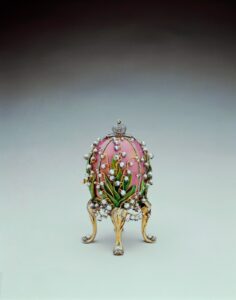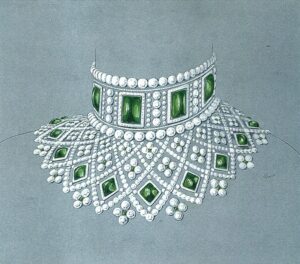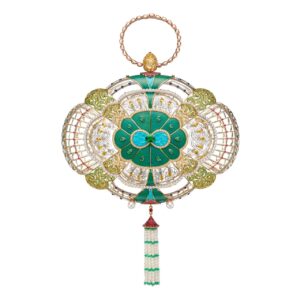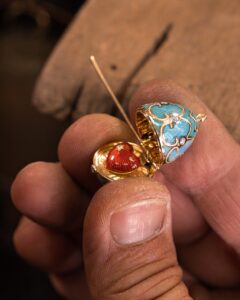Designing for a jewellery brand like Fabergé is like delving into a treasure trove of history. Born in 1842 the brand is one of the oldest jewellery houses in the world and its creativity has continued to inspire for generations.

Combining fine art with high jewellery and watchmaking, Fabergé has produced some of the most complicated, precious designs ever to be made and today, it continues to be inspired by its heritage, while at the same time remaining relevant for today’s consumer. Born in Finland, Liisa Tallgren grew up surrounded by creative influences and her love for art and painting soon developed into a passion for metalwork. In 2006 Liisa gained a BA Hons in Silversmithing, Goldsmithing and Jewellery which began her career in jewellery design.
Liisa joined Fabergé as their Designer in 2013. More than just a traditional designer Liisa is heavily involved in the full design process from initial concepts, through to technical drawings. An artist at heart, she also creates beautiful paintings of bespoke creations which are gifted to clients, offering a personal touch to her designs.

Fabergé has recently unveiled a one-of-a-kind Majesty Clutch Bag which is available exclusively at The Dubai Mall store. This exquisite piece is the first wearable object of its kind to be created by the house since 1917. Its opulent design celebrates the glamour and splendour of Fabergé’s rich heritage in a contemporary design. Here we discover more on this exceptional piece with Liisa Tallgren as well as the secrets behind designing jewellery for such a unique Maison.
Can you tell us about your vision and direction for the design at Fabergé?
My vision for Fabergé is to create jewellery and objet d’arts to the highest standard of design and craftsmanship, something that will be cherished by the owners for years to come.
How do you think your creative background benefits you when working for a brand that has such a rich history in creativity?
I went to a school where we didn’t have printed school books, instead we had to write the text and draw the pictures ourselves. I especially loved illustrating biology and art history. Drawing and painting always felt natural and those skills are crucial for communicating design ideas. Experimenting with different materials, such as wood or clay, helps me to understand three-dimensional volume and how the characteristics of each material affect the look and practicality of the creation.

What is an era or piece from Fabergé’s heritage they you are most amazed by?
The Imperial Lilies of the Valley Egg of 1898. The egg is decorated with pink enamel, the recipe of which has been lost over time and cannot be replicated at present. Pearls are presented as lilies of the valley and have very subtle diamond accents. The design as a whole is almost kitsch, but the combination of colours and textures is stunning and somehow makes it all work.
Tell us about some of the latest creations you have designed?
I mainly work on bespoke designs which are confidential. They vary in size and complexity but there have been a few especially nice pieces involving coloured gemstones and enamel recently. One of the highlights has definitely been the Game of Thrones Egg, which is a collaboration with the Game of Thrones costume designer, Michele Clapton. The egg is the most complex and precious piece we have made so far and it is amazing to see something of that calibre being made today.

Lilies of the Valley egg
What can you tell us about the Majesty Clutch Bag that has been designed exclusively for the UAE?
The Majesty Clutch Bag is a one-of-a-kind masterpiece and is the first wearable object of its kind created by Fabergé since 1917. This exceptional piece has been created from carved rock crystal, carved natural turquoise and teal blue guilloche enamel, all set in 18k yellow, white and rose gold and adorned with a multitude of gemstones including diamonds, pearls, yellow and pink sapphires, tsavorites, Gemfields Mozambican rubies and Zambian emeralds. This unique combination of materials plays with both colour and transparency to create a striking accessory that pushes the boundaries of design.
How do you think women in the Middle East resonate with Fabergé’s designs and brand DNA?
Fabergé’s pieces are appreciated around the globe for their timeless design and immaculate craftsmanship!

Romanov Necklace Sketch
Tell us a little about your creative process?
I sketch by hand until something I feel is worth developing emerges on paper. The next step is drawing a vector file which helps with accuracy and speed, and at that stage I draw multiple versions, always making a small difference each time, working with scale and proportions. Ideas come very easily and quickly but narrowing them down and refining them to a form that works in the real world is the tricky part. Sometimes the best design is something very traditional with a small twist in its details.
Can you tell us a little about the process when you are creating bespoke pieces for clients?
I rarely meet clients in person as they can be based anywhere in the world, so I receive all the details for requests from our lovely sales team. The requests are very different, sometimes clients want something very specific, in which case I need to follow instructions carefully or do research on their chosen theme. But it always starts with a hand-drawn sketch.

What is something you would love to design that you haven’t done yet?
A chandelier!
When are you at your most creative state of mind?
When I have had a cup of coffee and some chocolates!
Who or what inspires you the most?
Nature, gardens and people who make something out of nothing.

As well as designing, we know you do a lot of painting – tell us about this and how do the two complement each other in your role at Fabergé?
There is so much to learn about shapes and colours that the learning is ongoing, at least for me. Artists and designers often talk about the story behind an artwork with words, but I think shapes and colours also communicate by themselves. A shape can look happy or sad without a text that describes it, but like words, visual language can also deceive. These discoveries are what drive me to learn more about visual expression and the more I do it, the more I learn. This supports my design projects because good illustration skills are crucial for a designer, and so is understanding the overall feeling or atmosphere of an artwork or object. Painting and designing are similar but different enough to give a refreshing break from each other.
What else can we expect to see for the rest of the year and into 2022?
We keep a lot under wraps, but it involves colour and sparkle!
What is a decade or era throughout Fabergé’s history that inspires you the most?
What I admire the most in Fabergé before the revolution is the skilled enamel work, and the use of colour and the combination of textures in general, and the way materials were selected based on their beauty rather than just the value. Of course, the current decade is the most exciting in a way because of the freedom of expression that followed modernism and postmodernism and all the new techniques and materials that are available. The unknown can be scary but also exciting!

What is your favourite stone to work with?
I love working with a range of colours rather than just one, both precious and semi-precious. But, if I had to pick one it would be emerald.















